
A | B | C | D | E | F | G | H | CH | I | J | K | L | M | N | O | P | Q | R | S | T | U | V | W | X | Y | Z | 0 | 1 | 2 | 3 | 4 | 5 | 6 | 7 | 8 | 9


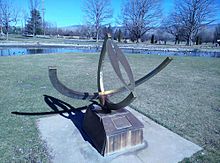
A sundial is a horological device that tells the time of day (referred to as civil time in modern usage) when direct sunlight shines by the apparent position of the Sun in the sky. In the narrowest sense of the word, it consists of a flat plate (the dial) and a gnomon, which casts a shadow onto the dial. As the Sun appears to move through the sky, the shadow aligns with different hour-lines, which are marked on the dial to indicate the time of day. The style is the time-telling edge of the gnomon, though a single point or nodus may be used. The gnomon casts a broad shadow; the shadow of the style shows the time. The gnomon may be a rod, wire, or elaborately decorated metal casting. The style must be parallel to the axis of the Earth's rotation for the sundial to be accurate throughout the year. The style's angle from horizontal is equal to the sundial's geographical latitude.
The term sundial can refer to any device that uses the Sun's altitude or azimuth (or both) to show the time. Sundials are valued as decorative objects, metaphors, and objects of intrigue and mathematical study.
The passing of time can be observed by placing a stick in the sand or a nail in a board and placing markers at the edge of a shadow or outlining a shadow at intervals. It is common for inexpensive, mass-produced decorative sundials to have incorrectly aligned gnomons, shadow lengths, and hour-lines, which cannot be adjusted to tell correct time.[2]
Introduction
There are several different types of sundials. Some sundials use a shadow or the edge of a shadow while others use a line or spot of light to indicate the time.
The shadow-casting object, known as a gnomon, may be a long thin rod or other object with a sharp tip or a straight edge. Sundials employ many types of gnomon. The gnomon may be fixed or moved according to the season. It may be oriented vertically, horizontally, aligned with the Earth's axis, or oriented in an altogether different direction determined by mathematics.
Given that sundials use light to indicate time, a line of light may be formed by allowing the Sun's rays through a thin slit or focusing them through a cylindrical lens. A spot of light may be formed by allowing the Sun's rays to pass through a small hole, window, oculus, or by reflecting them from a small circular mirror. A spot of light can be as small as a pinhole in a solargraph or as large as the oculus in the Pantheon.
Sundials also may use many types of surfaces to receive the light or shadow. Planes are the most common surface, but partial spheres, cylinders, cones and other shapes have been used for greater accuracy or beauty.
Sundials differ in their portability and their need for orientation. The installation of many dials requires knowing the local latitude, the precise vertical direction (e.g., by a level or plumb-bob), and the direction to true north. Portable dials are self-aligning: for example, it may have two dials that operate on different principles, such as a horizontal and analemmatic dial, mounted together on one plate. In these designs, their times agree only when the plate is aligned properly.
Sundials may indicate the local solar time only. To obtain the national clock time, three corrections are required:
- The orbit of the Earth is not perfectly circular and its rotational axis is not perpendicular to its orbit. The sundial's indicated solar time thus varies from clock time by small amounts that change throughout the year. This correction—which may be as great as 16 minutes, 33 seconds—is described by the equation of time. A sophisticated sundial, with a curved style or hour lines, may incorporate this correction. The more usual simpler sundials sometimes have a small plaque that gives the offsets at various times of the year.
- The solar time must be corrected for the longitude of the sundial relative to the longitude of the official time zone. For example, an uncorrected sundial located west of Greenwich, England but within the same time-zone, shows an earlier time than the official time. It may show "11:45" at official noon, and will show "noon" after the official noon. This correction can easily be made by rotating the hour-lines by a constant angle equal to the difference in longitudes, which makes this a commonly possible design option.
- To adjust for daylight saving time, if applicable, the solar time must additionally be shifted for the official difference (usually one hour). This is also a correction that can be done on the dial, i.e. by numbering the hour-lines with two sets of numbers, or even by swapping the numbering in some designs. More often this is simply ignored, or mentioned on the plaque with the other corrections, if there is one.
Apparent motion of the Sun
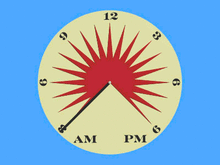
The principles of sundials are understood most easily from the Sun's apparent motion.[3] The Earth rotates on its axis, and revolves in an elliptical orbit around the Sun. An excellent approximation assumes that the Sun revolves around a stationary Earth on the celestial sphere, which rotates every 24 hours about its celestial axis. The celestial axis is the line connecting the celestial poles. Since the celestial axis is aligned with the axis about which the Earth rotates, the angle of the axis with the local horizontal is the local geographical latitude.
Unlike the fixed stars, the Sun changes its position on the celestial sphere, being (in the northern hemisphere) at a positive declination in spring and summer, and at a negative declination in autumn and winter, and having exactly zero declination (i.e., being on the celestial equator) at the equinoxes. The Sun's celestial longitude also varies, changing by one complete revolution per year. The path of the Sun on the celestial sphere is called the ecliptic. The ecliptic passes through the twelve constellations of the zodiac in the course of a year.
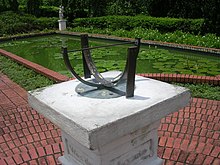
This model of the Sun's motion helps to understand sundials. If the shadow-casting gnomon is aligned with the celestial poles, its shadow will revolve at a constant rate, and this rotation will not change with the seasons. This is the most common design. In such cases, the same hour lines may be used throughout the year. The hour-lines will be spaced uniformly if the surface receiving the shadow is either perpendicular (as in the equatorial sundial) or circular about the gnomon (as in the armillary sphere).
In other cases, the hour-lines are not spaced evenly, even though the shadow rotates uniformly. If the gnomon is not aligned with the celestial poles, even its shadow will not rotate uniformly, and the hour lines must be corrected accordingly. The rays of light that graze the tip of a gnomon, or which pass through a small hole, or reflect from a small mirror, trace out a cone aligned with the celestial poles. The corresponding light-spot or shadow-tip, if it falls onto a flat surface, will trace out a conic section, such as a hyperbola, ellipse or (at the North or South Poles) a circle.
This conic section is the intersection of the cone of light rays with the flat surface. This cone and its conic section change with the seasons, as the Sun's declination changes; hence, sundials that follow the motion of such light-spots or shadow-tips often have different hour-lines for different times of the year. This is seen in shepherd's dials, sundial rings, and vertical gnomons such as obelisks. Alternatively, sundials may change the angle or position (or both) of the gnomon relative to the hour lines, as in the analemmatic dial or the Lambert dial.
History
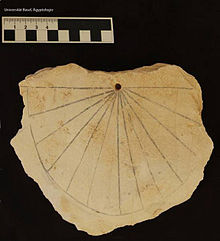
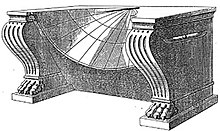
The earliest sundials known from the archaeological record are shadow clocks (1500 BC or BCE) from ancient Egyptian astronomy and Babylonian astronomy. Presumably, humans were telling time from shadow-lengths at an even earlier date, but this is hard to verify. In roughly 700 BC, the Old Testament describes a sundial—the "dial of Ahaz" mentioned in Isaiah 38:8 and 2 Kings 20:11. By 240 BC Eratosthenes had estimated the circumference of the world using an obelisk and a water well and a few centuries later Ptolemy had charted the latitude of cities using the angle of the sun. The people of Kush created sun dials through geometry.[4][5] The Roman writer Vitruvius lists dials and shadow clocks known at that time in his De architectura. The Tower of Winds constructed in Athens included sundial and a water clock for telling time. A canonical sundial is one that indicates the canonical hours of liturgical acts. Such sundials were used from the 7th to the 14th centuries by the members of religious communities. The Italian astronomer Giovanni Padovani published a treatise on the sundial in 1570, in which he included instructions for the manufacture and laying out of mural (vertical) and horizontal sundials. Giuseppe Biancani's Constructio instrumenti ad horologia solaria (c. 1620) discusses how to make a perfect sundial. They have been commonly used since the 16th century.
Functioning
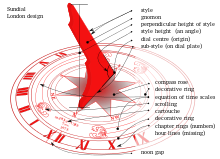
In general, sundials indicate the time by casting a shadow or throwing light onto a surface known as a dial face or dial plate. Although usually a flat plane, the dial face may also be the inner or outer surface of a sphere, cylinder, cone, helix, and various other shapes.
The time is indicated where a shadow or light falls on the dial face, which is usually inscribed with hour lines. Although usually straight, these hour lines may also be curved, depending on the design of the sundial (see below). In some designs, it is possible to determine the date of the year, or it may be required to know the date to find the correct time. In such cases, there may be multiple sets of hour lines for different months, or there may be mechanisms for setting/calculating the month. In addition to the hour lines, the dial face may offer other data—such as the horizon, the equator and the tropics—which are referred to collectively as the dial furniture.
The entire object that casts a shadow or light onto the dial face is known as the sundial's gnomon.[6] However, it is usually only an edge of the gnomon (or another linear feature) that casts the shadow used to determine the time; this linear feature is known as the sundial's style. The style is usually aligned parallel to the axis of the celestial sphere, and therefore is aligned with the local geographical meridian. In some sundial designs, only a point-like feature, such as the tip of the style, is used to determine the time and date; this point-like feature is known as the sundial's nodus.[6][a] Some sundials use both a style and a nodus to determine the time and date.
The gnomon is usually fixed relative to the dial face, but not always; in some designs such as the analemmatic sundial, the style is moved according to the month. If the style is fixed, the line on the dial plate perpendicularly beneath the style is called the substyle,[6] meaning "below the style". The angle the style makes with the plane of the dial plate is called the substyle height, an unusual use of the word height to mean an angle. On many wall dials, the substyle is not the same as the noon line (see below). The angle on the dial plate between the noon line and the substyle is called the substyle distance, an unusual use of the word distance to mean an angle.
By tradition, many sundials have a motto. The motto is usually in the form of an epigram: sometimes sombre reflections on the passing of time and the brevity of life, but equally often humorous witticisms of the dial maker. One such quip is, I am a sundial, and I make a botch, Of what is done much better by a watch.[7]
A dial is said to be equiangular if its hour-lines are straight and spaced equally. Most equiangular sundials have a fixed gnomon style aligned with the Earth's rotational axis, as well as a shadow-receiving surface that is symmetrical about that axis; examples include the equatorial dial, the equatorial bow, the armillary sphere, the cylindrical dial and the conical dial. However, other designs are equiangular, such as the Lambert dial, a version of the analemmatic sundial with a moveable style.
In the Southern Hemisphere
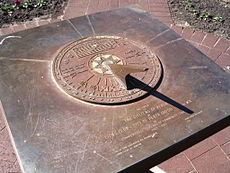
A sundial at a particular latitude in one hemisphere must be reversed for use at the opposite latitude in the other hemisphere.[8] A vertical direct south sundial in the Northern Hemisphere becomes a vertical direct north sundial in the Southern Hemisphere. To position a horizontal sundial correctly, one has to find true north or south. The same process can be used to do both.[9] The gnomon, set to the correct latitude, has to point to the true south in the Southern Hemisphere as in the Northern Hemisphere it has to point to the true north.[10] The hour numbers also run in opposite directions, so on a horizontal dial they run anticlockwise (US: counterclockwise) rather than clockwise.[11]
Sundials which are designed to be used with their plates horizontal in one hemisphere can be used with their plates vertical at the complementary latitude in the other hemisphere. For example, the illustrated sundial in Perth, Australia, which is at latitude 32° South, would function properly if it were mounted on a south-facing vertical wall at latitude 58° (i.e. 90° − 32°) North, which is slightly further north than Perth, Scotland. The surface of the wall in Scotland would be parallel with the horizontal ground in Australia (ignoring the difference of longitude), so the sundial would work identically on both surfaces. Correspondingly, the hour marks, which run counterclockwise on a horizontal sundial in the southern hemisphere, also do so on a vertical sundial in the northern hemisphere. (See the first two illustrations at the top of this article.) On horizontal northern-hemisphere sundials, and on vertical southern-hemisphere ones, the hour marks run clockwise.
Adjustments to calculate clock time from a sundial reading
The most common reason for a sundial to differ greatly from clock time is that the sundial has not been oriented correctly or its hour lines have not been drawn correctly. For example, most commercial sundials are designed as horizontal sundials as described above. To be accurate, such a sundial must have been designed for the local geographical latitude and its style must be parallel to the Earth's rotational axis; the style must be aligned with true north and its height (its angle with the horizontal) must equal the local latitude. To adjust the style height, the sundial can often be tilted slightly "up" or "down" while maintaining the style's north-south alignment.[12]
Summer (daylight saving) time correction
Some areas of the world practice daylight saving time, which changes the official time, usually by one hour. This shift must be added to the sundial's time to make it agree with the official time.
Time-zone (longitude) correction
A standard time zone covers roughly 15° of longitude, so any point within that zone which is not on the reference longitude (generally a multiple of 15°) will experience a difference from standard time that is equal to 4 minutes of time per degree. For illustration, sunsets and sunrises are at a much later "official" time at the western edge of a time-zone, compared to sunrise and sunset times at the eastern edge. If a sundial is located at, say, a longitude 5° west of the reference longitude, then its time will read 20 minutes slow, since the Sun appears to revolve around the Earth at 15° per hour. This is a constant correction throughout the year. For equiangular dials such as equatorial, spherical or Lambert dials, this correction can be made by rotating the dial surface by an angle equaling the difference in longitude, without changing the gnomon position or orientation. However, this method does not work for other dials, such as a horizontal dial; the correction must be applied by the viewer.
However, for political and practical reasons, time-zone boundaries have been skewed. At their most extreme, time zones can cause official noon, including daylight savings, to occur up to three hours early (in which case the Sun is actually on the meridian at official clock time of 3 PM). This occurs in the far west of Alaska, China, and Spain. For more details and examples, see time zones.
Equation of time correction

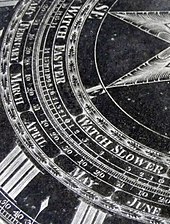
Although the Sun appears to rotate uniformly about the Earth, in reality this motion is not perfectly uniform. This is due to the eccentricity of the Earth's orbit (the fact that the Earth's orbit about the Sun is not perfectly circular, but slightly elliptical) and the tilt (obliquity) of the Earth's rotational axis relative to the plane of its orbit. Therefore, sundial time varies from standard clock time. On four days of the year, the correction is effectively zero. However, on others, it can be as much as a quarter-hour early or late. The amount of correction is described by the equation of time. This correction is equal worldwide: it does not depend on the local latitude or longitude of the observer's position. It does, however, change over long periods of time, (centuries or more,[13]) because of slow variations in the Earth's orbital and rotational motions. Therefore, tables and graphs of the equation of time that were made centuries ago are now significantly incorrect. The reading of an old sundial should be corrected by applying the present-day equation of time, not one from the period when the dial was made.
In some sundials, the equation of time correction is provided as an informational plaque affixed to the sundial, for the observer to calculate. In more sophisticated sundials the equation can be incorporated automatically. For example, some equatorial bow sundials are supplied with a small wheel that sets the time of year; this wheel in turn rotates the equatorial bow, offsetting its time measurement. In other cases, the hour lines may be curved, or the equatorial bow may be shaped like a vase, which exploits the changing altitude of the sun over the year to effect the proper offset in time.[14]
A heliochronometer is a precision sundial first devised in about 1763 by Philipp Hahn and improved by Abbé Guyoux in about 1827.[15] It corrects apparent solar time to mean solar time or another standard time. Heliochronometers usually indicate the minutes to within 1 minute of Universal Time.

The Sunquest sundial, designed by Richard L. Schmoyer in the 1950s, uses an analemmic-inspired gnomon to cast a shaft of light onto an equatorial time-scale crescent. Sunquest is adjustable for latitude and longitude, automatically correcting for the equation of time, rendering it "as accurate as most pocket watches".[16][17][18][19]
Similarly, in place of the shadow of a gnomon the "sundial at Miguel Hernández University". 30 November 2017. uses the solar projection of a graph of the equation of time intersecting a time scale to display clock time directly.
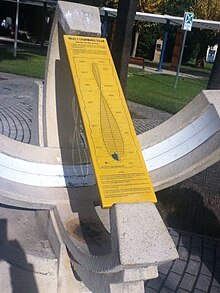
An analemma may be added to many types of sundials to correct apparent solar time to mean solar time or another standard time. These usually have hour lines shaped like "figure eights" (analemmas) according to the equation of time. This compensates for the slight eccentricity in the Earth's orbit and the tilt of the Earth's axis that causes up to a 15 minute variation from mean solar time. This is a type of dial furniture seen on more complicated horizontal and vertical dials.
Prior to the invention of accurate clocks, in the mid 17th century, sundials were the only timepieces in common use, and were considered to tell the "right" time. The equation of time was not used. After the invention of good clocks, sundials were still considered to be correct, and clocks usually incorrect. The equation of time was used in the opposite direction from today, to apply a correction to the time shown by a clock to make it agree with sundial time. Some elaborate "equation clocks", such as one made by Joseph Williamson in 1720, incorporated mechanisms to do this correction automatically. (Williamson's clock may have been the first-ever device to use a differential gear.) Only after about 1800 was uncorrected clock time considered to be "right", and sundial time usually "wrong", so the equation of time became used as it is today.[20]
With fixed axial gnomon
The most commonly observed sundials are those in which the shadow-casting style is fixed in position and aligned with the Earth's rotational axis, being oriented with true north and south, and making an angle with the horizontal equal to the geographical latitude. This axis is aligned with the celestial poles, which is closely, but not perfectly, aligned with the pole star Polaris. For illustration, the celestial axis points vertically at the true North Pole, where it points horizontally on the equator. The world's largest axial gnomon sundial is the mast of the Sundial Bridge at Turtle Bay in Redding, California . A formerly world's largest gnomon is at Jaipur, raised 26°55′ above horizontal, reflecting the local latitude.[21]
On any given day, the Sun appears to rotate uniformly about this axis, at about 15° per hour, making a full circuit (360°) in 24 hours. A linear gnomon aligned with this axis will cast a sheet of shadow (a half-plane) that, falling opposite to the Sun, likewise rotates about the celestial axis at 15° per hour. The shadow is seen by falling on a receiving surface that is usually flat, but which may be spherical, cylindrical, conical or of other shapes. If the shadow falls on a surface that is symmetrical about the celestial axis (as in an armillary sphere, or an equatorial dial), the surface-shadow likewise moves uniformly; the hour-lines on the sundial are equally spaced. However, if the receiving surface is not symmetrical (as in most horizontal sundials), the surface shadow generally moves non-uniformly and the hour-lines are not equally spaced; one exception is the Lambert dial described below.
Some types of sundials are designed with a fixed gnomon that is not aligned with the celestial poles like a vertical obelisk. Such sundials are covered below under the section, "Nodus-based sundials".
Empirical hour-line marking
The formulas shown in the paragraphs below allow the positions of the hour-lines to be calculated for various types of sundial. In some cases, the calculations are simple; in others they are extremely complicated. There is an alternative, simple method of finding the positions of the hour-lines which can be used for many types of sundial, and saves a lot of work in cases where the calculations are complex.[22] This is an empirical procedure in which the position of the shadow of the gnomon of a real sundial is marked at hourly intervals. The equation of time must be taken into account to ensure that the positions of the hour-lines are independent of the time of year when they are marked. An easy way to do this is to set a clock or watch so it shows "sundial time"[b] which is standard time,[c] plus the equation of time on the day in question.[d] The hour-lines on the sundial are marked to show the positions of the shadow of the style when this clock shows whole numbers of hours, and are labelled with these numbers of hours. For example, when the clock reads 5:00, the shadow of the style is marked, and labelled "5" (or "V" in Roman numerals). If the hour-lines are not all marked in a single day, the clock must be adjusted every day or two to take account of the variation of the equation of time.
Equatorial sundials
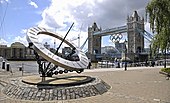

The distinguishing characteristic of the equatorial dial (also called the equinoctial dial) is the planar surface that receives the shadow, which is exactly perpendicular to the gnomon's style.[25] This plane is called equatorial, because it is parallel to the equator of the Earth and of the celestial sphere. If the gnomon is fixed and aligned with the Earth's rotational axis, the sun's apparent rotation about the Earth casts a uniformly rotating sheet of shadow from the gnomon; this produces a uniformly rotating line of shadow on the equatorial plane. Since the Earth rotates 360° in 24 hours, the hour-lines on an equatorial dial are all spaced 15° apart (360/24).
The uniformity of their spacing makes this type of sundial easy to construct. If the dial plate material is opaque, both sides of the equatorial dial must be marked, since the shadow will be cast from below in winter and from above in summer. With translucent dial plates (e.g. glass) the hour angles need only be marked on the sun-facing side, although the hour numberings (if used) need be made on both sides of the dial, owing to the differing hour schema on the sun-facing and sun-backing sides.
Another major advantage of this dial is that equation of time (EoT) and daylight saving time (DST) corrections can be made by simply rotating the dial plate by the appropriate angle each day. This is because the hour angles are equally spaced around the dial. For this reason, an equatorial dial is often a useful choice when the dial is for public display and it is desirable to have it show the true local time to reasonable accuracy. The EoT correction is made via the relation
Near the equinoxes in spring and autumn, the sun moves on a circle that is nearly the same as the equatorial plane; hence, no clear shadow is produced on the equatorial dial at those times of year, a drawback of the design.
A nodus is sometimes added to equatorial sundials, which allows the sundial to tell the time of year. On any given day, the shadow of the nodus moves on a circle on the equatorial plane, and the radius of the circle measures the declination of the sun. The ends of the gnomon bar may be used as the nodus, or some feature along its length. An ancient variant of the equatorial sundial has only a nodus (no style) and the concentric circular hour-lines are arranged to resemble a spider-web.[26]
Horizontal sundials
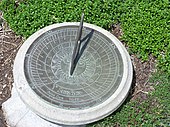
In the horizontal sundial (also called a garden sundial), the plane that receives the shadow is aligned horizontally, rather than being perpendicular to the style as in the equatorial dial.[27] Hence, the line of shadow does not rotate uniformly on the dial face; rather, the hour lines are spaced according to the rule.[28]
Or in other terms:
where L is the sundial's geographical latitude (and the angle the gnomon makes with the dial plate),
Antropológia
Aplikované vedy
Bibliometria
Dejiny vedy
Encyklopédie
Filozofia vedy
Forenzné vedy
Humanitné vedy
Knižničná veda
Kryogenika
Kryptológia
Kulturológia
Literárna veda
Medzidisciplinárne oblasti
Metódy kvantitatívnej analýzy
Metavedy
Metodika
Text je dostupný za podmienok Creative
Commons Attribution/Share-Alike License 3.0 Unported; prípadne za ďalších
podmienok.
Podrobnejšie informácie nájdete na stránke Podmienky
použitia.
www.astronomia.sk | www.biologia.sk | www.botanika.sk | www.dejiny.sk | www.economy.sk | www.elektrotechnika.sk | www.estetika.sk | www.farmakologia.sk | www.filozofia.sk | Fyzika | www.futurologia.sk | www.genetika.sk | www.chemia.sk | www.lingvistika.sk | www.politologia.sk | www.psychologia.sk | www.sexuologia.sk | www.sociologia.sk | www.veda.sk I www.zoologia.sk




